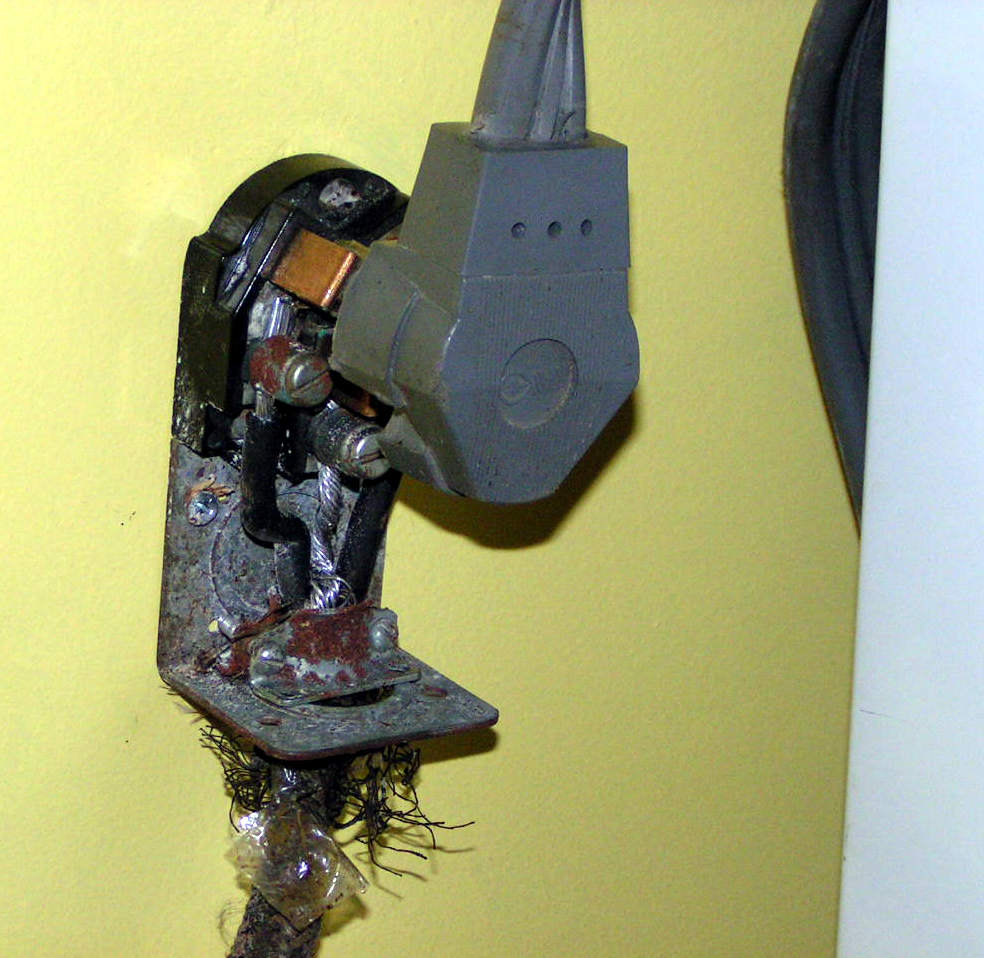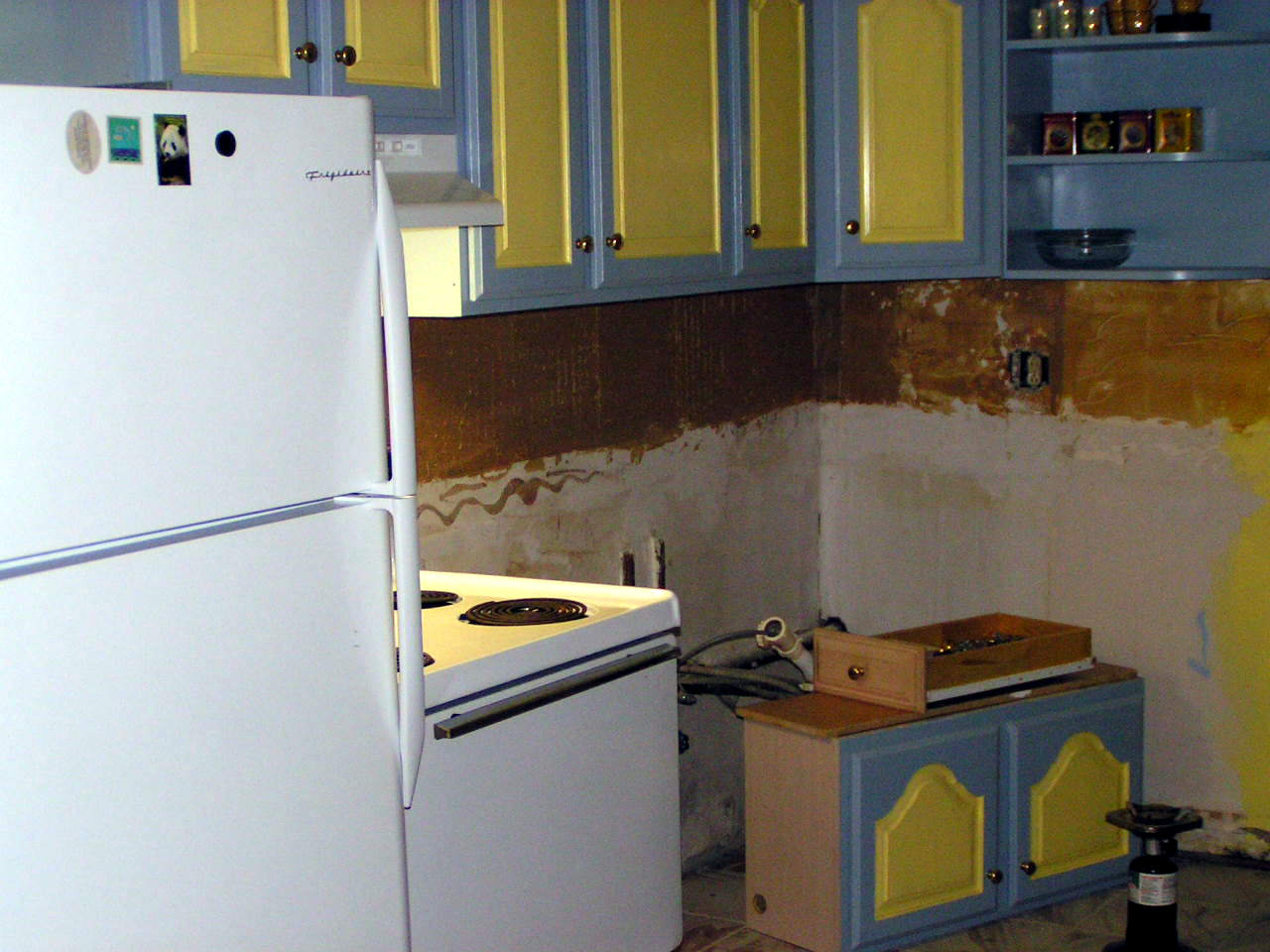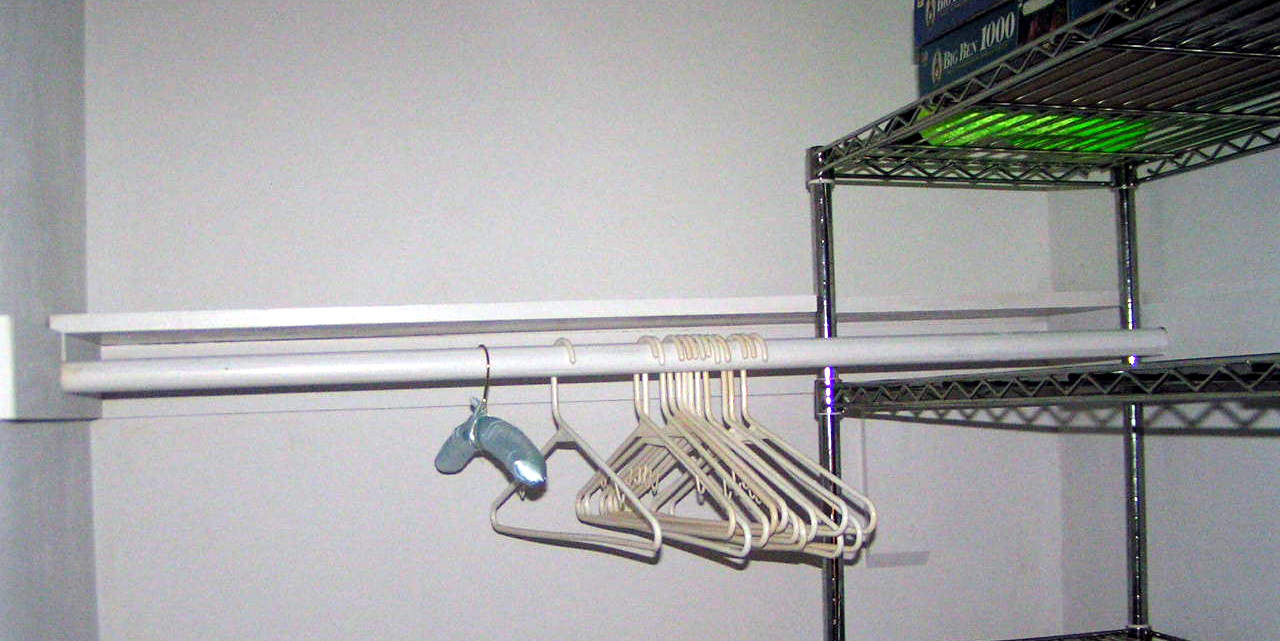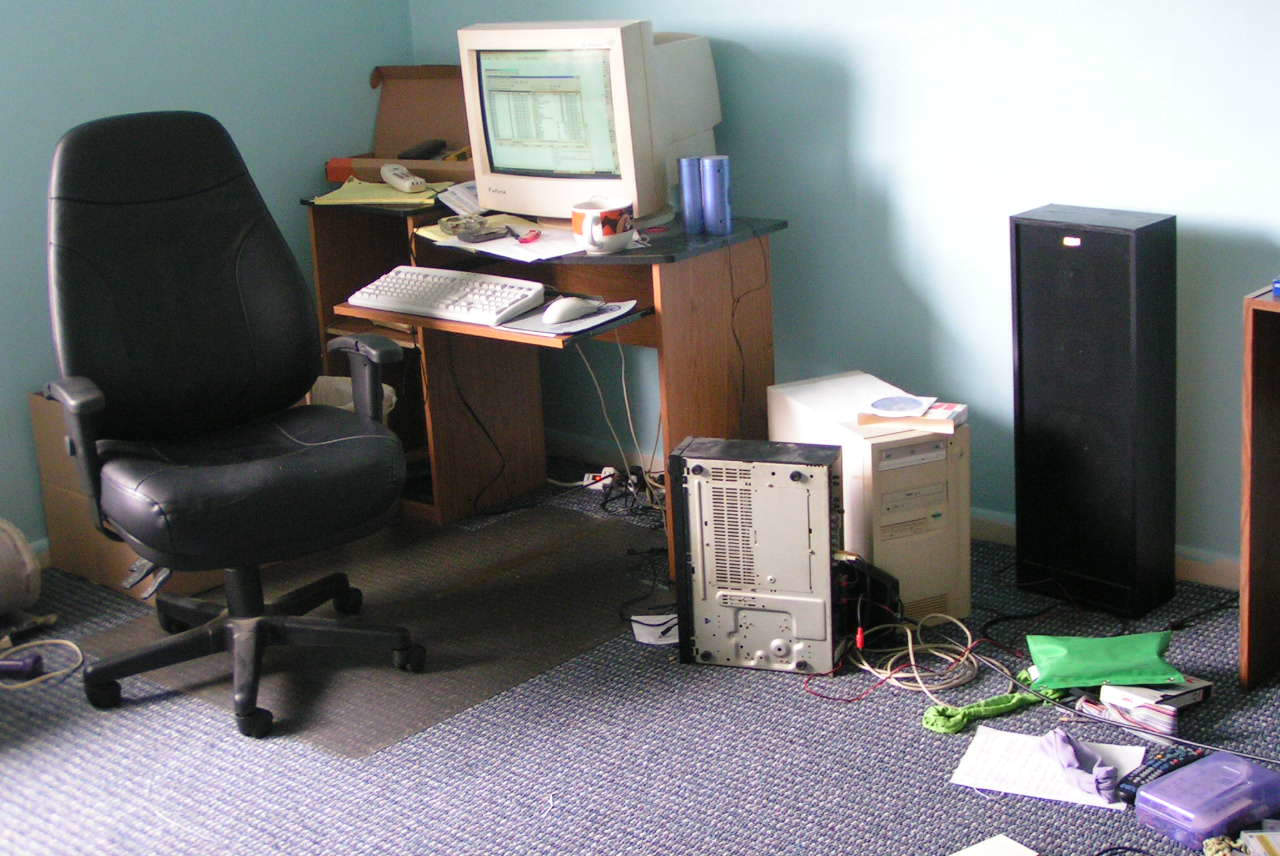15-VIII-2004.
In the morning, chat with David:
me: I can't be by the computer all the time, and I haven't installed amplifier - so I probably won't hear the bell from this window. But I'll hear the phone; there's one upstairs and one downstairs and they're both loud enough. So just call if I don't respond here.
he (10:45:38): Yes... sorry got delayed
he (10:46:21): I'll be at the office in about half an hour that would be 11h+ your time
he (10:48:33): Sorry again...
me (10:48:35): ok. Lena accidentally saw this one. I'm downstairs, fixing the oven receptacle. Alluminium...
he (10:48:49): Alluminum;..
he (10:49:02): go ahead then...
he (10:49:16): I just got home and our session requests citrix...
me (10:49:17): with copper and iron. NO - it's alluminium as far as I'm concerned
he (10:49:40): well in "your" country it's alluminum no?
me (10:50:19): they call it so. and it's even more correct, more compliant with chemical naming conventions. but they didn't do it because it's more correct, they did it because noone's gonna tell 'em whatta do.

Putting kitchen in order. I somehow put the stove cable right, and we also mounted the aspirator, it works, fan and light, it all works.
The cable is a jury rig par excellance. Alluminium, thus at least twice as thick as same strength copper. As we found out, the walls to neighbors are not slat and sheet, but rather, as the fire rules dictate, firm material, in this case slag blocks. They never heard of siporeks here, brick is too expensive, the concrete too cold and also expensive, so blocks it is. Schools, big box shops, university buildings are made of it. Most often not even properly plastered, just slightly smoothed over, edges still visible, and painted (drab or gray, of course). The outlet is on the wall, because, fucket, we can't expect an electrician to know how to make a groove in the wall, or to even have the tools for it. Two screws into the wall, done. Someone smashed the protecting box, I guess by moving the stove. The connection is four wires - two phases, zero, ground. In several places around the house we found the ground being connected to zero... which is why the blowdryers here have their own FID switch, but the house as a whole doesn't.

The stove came with the house, and is of the same type as what we had in apartments - the hot plates are not plates at all, the pot lies on the heating spiral. Around it is the drip catching vessel, with a slot for contacts. At least two spirals didn't work, which wasn't a problem, we simply bought new, the sizes and strengths are standard (7" or 8" was it?), and also those vessels, the old ones weren't even worth trying to scrub, considering their condition. The cost was about 14$ per plate.
The fridge, of course, opened the wrong way, but at least these american ones (while still available) are no problem, rescrew the hinges and the handles to the other side, in the holes provided, and move the hole stoppers to the now unused holes, done. They always make them with hinges on the right.
Still no sink. She washes the dishes in a vat of hot water from the bathroom, then spills it into the toilet.

Now the carpet in Lena's room's closet, and to assemble her shelf. But ouch, it's a closet, it has this pole to hang coats. And the pole is in the way. I still don't understand how I failed to take it out, what was the obstacle, why did I have to cut it. Made the cut at about 10cm near the right end. Then we put the shelf in and... well, why not put the pole back? I drilled a hole on both sides of the cut, found a screw with long enough thread, cut off the flat part, put some glue for good measure, screwed the two parts together. It's still like this.
Probably could have found some elegant solution, but for the speed, we didn't sit to think it over but rather Grumfed it on the fly. Looks funny, but gets the job done. As the old adage from 1969 goes - who runs doesn't see, who sees thinks it's supposed to be like that.

My workplace has settled. I brought the amp and screwed armrests to my chair. The mat below is from three years ago, can't use those wheels on the carpet, needs something smoother. Also doesn't make dents in the carpet this way. Burt's sound boxes had to be retired, they suffered too much already and didn't sound right. Using Go's big boxes from that sound system of four years ago, which she doesn't use anymore, got some Logitech's 5.1 system now. These boxes ain't much either but get the job done and the sound isn't bad, it's just that... it's somehow empty, something's missing and I can't see what. The amp is still Burt's, but it's annoying how it cracks when dialed low, and leaves one channel barely audible, and it's because of the switch which alternates between the two pairs of speakers. I once even opened it to see how can I remove, or bridge, or just short that switch, but it's a closed box and the wiring scheme is unclear, so I gave up.
David and I are planning the next weekend, 22nd, when we'll meet in NYC. Jüzek is also supposed to come, so we'll demo what we did so far, but first we'll do a „dressed rehearsal“ among us, in, say, two days from now, to walk ourselves through it first, see what works and what doesn't.
Excerpts from an email to my folks:
State owned (was in the end) so there was a regulation requiring the house to be ready for winter. Stickers with „winterized by so-and-so“ were everywhere. Even the water heater was empty. The one thing is done better than anywhere else: power. The wiring shows that some things were done by semiliterates, even the electrician said that the fuse board is technically OK, but no professional would do it like that. But this is the first place where it's all strong enough to not wink when something stronger is turned on. Switch the water heater on, and it has two heater elements at 2200W each, and you don't notice it on any of the lights; in each apartment the lights would visibly dim the moment an iron or blowdryer is turned on. Not here.
What is being replaced? :) Sinks, basins, windows, most of the walls, almost all power except outlets. I didn't say „and doors“, because we already took off three panes to various rooms and closets and junked them - it's a particle board frame with lesonit* cover. Some of predecessors had a mongrel, a sizable one it seems, so all the ground floor doors except the front were covered in scratches to the knob. (no handles, only those knobs that you have to turn 45° in either direction to open, which is why we first bought handles for the front and rear doors).
The barbecue cleaning spray cleaned the pipes enough. It doesn't cool as much as we got used to in the last two apartments, but cools sufficiently. We sweat only when we work, but at least it serves a purpose, the AC condensates the vapor on its cold pipes, so now sweating has some effect. Outside you can sweat all you like, if it's humid enough sweat won't evaporate, you sweat in vain, doesn't cool you off.
About my coming... Seems to be the other half of september in Belgium, then I'd hop from there. Of course, this is Jüzek's madhouse and the plans are written into the chimney. Anything may change anytime, this is just how it looks at the moment.
This on UA:
For a while I was toying with an idea of an insulting agency - I'd be writing articles for guys who were hit by someone in the papers, full of smart innuendos, latin quotations etc, with the intent that my client would appear eloquent, sharp-minded and well-read, while insulting his opponent heavily in each sentence. I'd probably award myself the title of main insultant.
I finally emailed the news about the move to Gary. He replied: „Congratulations! Looks like you got a fixer-upper. More power to you! A lot of work.“
----
* lesonit, fiberboard, was something invented, I guess, in Slovenia. It's pressed wooden pulp with glue, pretty much a particle board with particless thinner than 0,3mm, in sheets about 5mm thick. One side is smooth and the other is crosshatched with shallow grooves. It was used for soffits, shed doors (that's how we closed our shed between 1963 and 1971), shed walls, even chair tops, cabinet doors and whatnot. The trouble with it was that it didn't tolerate water, it would buckle and bend, and its edges couldn't hold chafing, they'd lose particles. Likewise, any motion would gradually widen the holes made by nails, and it would come loose.
In this case, it wasn't real lesonit, but something similarly thin and flimsy. I just used the term to avoid explanation.
Mentions: Alan Ford, David Krakovski, Gary Brandywine, Gorana Sredljević (Go), Jelena Sredljević (Lena), Reginald Burton Cape (Burt), siporeks, UbiquAgora (UA), Yisaac Kwiatnik (Jüzek), in serbian